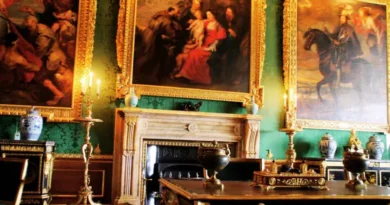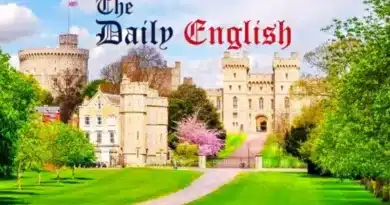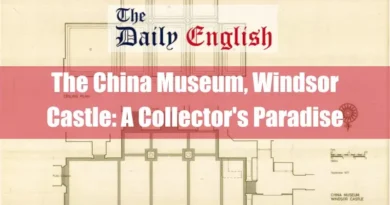The Waterloo Chamber, Windsor Castle
Key Takeaways
| Category | Details |
|---|---|
| A Commemorative Space | Built in the 1820s to celebrate the Allied victory at the Battle of Waterloo (1815) over Napoleon Bonaparte. |
| Commissioned by King George IV and designed by architect Jeffry Wyatville in the Regency style. | |
| Purpose: To commemorate the victory and honour the leaders involved. | |
| Grand Design and Décor | Large rectangular room (approx. 30 metres long and 15 metres wide) with high ceilings and large windows for natural light. |
| Walls adorned with 28 portraits by Sir Thomas Lawrence depicting key Allied figures (e.g., Duke of Wellington, Tsar Alexander I). | |
| Features intricate limewood carvings by Grinling Gibbons salvaged from the demolished Royal Chapel. | |
| Rich colours (red, gold, blue) and military trophies on friezes emphasise the celebratory theme. | |
| Architectural style: Neoclassical. | |
| Artistic Significance | Sir Thomas Lawrence’s portraits are Regency masterpieces, showcasing personalities and historical significance. |
| Symbolism and allegory convey themes of victory, peace, and Allied coalition power. | |
| Beyond Celebration | Ceremonial Use: Venue for events like Investitures, where honours are awarded by the monarch. |
| Public Access: Open as part of the Windsor Castle visitor route, except during special events or royal ceremonies. | |
| Photography: Generally not permitted inside, including the Waterloo Chamber. | |
| Accessibility: Measures available at Windsor Castle; check the Royal Collection Trust website for specifics. | |
| Tours: Included in Windsor Castle guided/self-guided tours; virtual tours may also be available. | |
| Enduring Legacy | Reflects Regency England’s artistic and political spirit. |
| Provides historical insight into leadership, war, and diplomacy. | |
| A monument to a pivotal European historical moment with enduring significance. |
I. Introduction
The Waterloo Chamber is a large room at Windsor Castle in England, built to commemorate the Allied victory over Napoleon Bonaparte at the Battle of Waterloo in 1815. While architect Jeffry Wyatville proposed locations for the chamber, its construction occurred during the reign of King William IV and was completed around 1830-31.
The chamber walls are lined with portraits of the monarchs, commanders, and politicians who played a role in the Napoleonic Wars, and the painting was by Sir Thomas Lawrence. The room is also decorated with limewood carvings by Grinling Gibbons and his assistants, salvaged from the former Royal chapel during its demolition in the 1820s.
The Waterloo Chamber is one of the most popular rooms at Windsor Castle and is used by the Royal Family for investiture ceremonies. It is also open to the public for most of the year.
II. History and Context

A. The Aftermath of Waterloo: The Rise of a Celebration
The Battle of Waterloo, fought on June 18, 1815, marked a pivotal moment in European history. The decisive victory of the Allied forces, led by the Duke of Wellington over Napoleon Bonaparte’s French army, ended the Napoleonic Wars that had ravaged Europe for over two decades. The news was met with jubilation across Britain, a nation that had been deeply involved in the conflict. A wave of celebratory sentiment swept the country, with public processions, thanksgiving services, and the issuance of commemorative medals.
This sense of triumph extended to the British monarchy. King George IV, who had ascended the throne in 1820, had played a key role in forging alliances against Napoleon. The victory at Waterloo solidified his position as a symbol of national resilience and solidified Britain’s status as a leading European power. The desire to commemorate this historic event and the king’s contribution became the driving force behind the creation of the Waterloo Chamber.
B. Commissioning the Chamber: A King’s Vision
King George IV, known for his extravagant tastes and interest in the arts, envisioned a grand chamber at Windsor Castle dedicated to the heroes of Waterloo. Reflecting his desire to commemorate the victory, he commissioned architect Jeffry Wyatville in 1828 to propose locations for the chamber as part of a significant remodelling project at the castle. Wyatville, a prominent Regency architect known for his Gothic Revival style, was tasked with creating a new stateroom that would not only celebrate the victory but also serve as a testament to British military might and diplomatic prowess.
C. Replacing the Past, Creating a Legacy
To create space for the Waterloo Chamber, construction overseen during the reign of King William IV involved the demolition of a suite of nine smaller 17th-century rooms, including the Queen’s Drawing Room, King’s Presence Chamber, and King’s Dining Chamber. This decision reflected the changing needs and aspirations of the monarchy. The grandeur and scale of the Waterloo Chamber were intended to surpass the preceding rooms, symbolizing a new era and a shift in focus towards commemorating recent military triumphs. The chamber’s placement within the castle, along the State Apartments route, ensured it would become a prominent feature for visiting dignitaries and guests.
III. Design and Architecture

A. A Grand Stage for Heroes
The Waterloo Chamber is a magnificent example of Regency architecture. Jeffry Wyatville designed it as a large, rectangular room with a coved ceiling. Its dimensions are impressive: 33 feet (10 meters) wide, 63 feet (19 meters) long, and 24 feet (7.3 meters) high. The space is dominated by large windows on two sides, bathing the room in natural light. This emphasis on light, a characteristic of Regency architecture, creates a sense of grandeur and openness. The chamber layout is designed to draw the eye towards the long walls, the prime location for the room’s most prominent feature: the portrait gallery.
B. Decorative Elements: Celebrating Victory
1. Portraits by Sir Thomas Lawrence: A Gallery of Leaders
The walls of the Waterloo Chamber are adorned with a series of 28 portraits by Sir Thomas Lawrence, a renowned British portrait artist. King George IV personally commissioned Lawrence to paint portraits of the key figures who played a role in the Napoleonic Wars and the subsequent peace negotiations at the Congress of Vienna. This distinguished company includes monarchs, military commanders, and statesmen from Britain, Prussia, Austria, and Russia, the Allied nations that ultimately defeated Napoleon.
a. Selection of Figures
Lawrence’s portraits depict a diverse range of individuals. Prominent figures include:
- The Duke of Wellington, the British commander at Waterloo.
- King George III of Britain reigned during much of the Napoleonic Wars.
- Tsar Alexander I of Russia was a key figure in the Allied coalition.
- Emperor Francis I of Austria was another crucial player on the Allied side.
- Prince Klemens von Metternich was the influential Austrian diplomat who led the Congress of Vienna.
The selection of figures reflects not only their military contributions but also their role in forging alliances and securing a lasting peace after Napoleon’s defeat.
b. Style and Composition
Lawrence’s portraits are characterised by their lifelike quality, attention to detail, and dramatic flair. He employed a full-length format for many of the portraits, further emphasising the stature and importance of the individuals depicted. The use of rich colours and theatrical poses contributes to the grandeur and celebration within the chamber.
2. Grinling Gibbons’ Carvings: Salvaged Grandeur
Another notable decorative element in the Waterloo Chamber is the intricate limewood carvings by the renowned sculptor Grinling Gibbons and his workshop. These carvings, originally created to decorate the Royal Chapel at Windsor Castle in the late 17th century, were salvaged when the chapel was demolished to make way for Wyatville’s remodelling project.
a. Origin of the Carvings
Gibbons, a master of the Baroque style, was known for his virtuosity in woodcarving. His work for the RoChapelapel encompassed various decorative elements, including swags, garlands, and cherubs. These intricate carvings embodied the exuberant style of the Baroque period and added a touch of opulence to the sacred space.
b. Incorporation into the Chamber’s Design
Wyatville skillfully incorporated Gibbons’ salvaged carvings into the design of the Waterloo Chamber. The carvings were carefully arranged to decorate the ceiling panels, friezes, and door frames. While the overall aesthetic of the chamber leans towards Regency classicism, including the Baroque carvings, it adds a layer of historical depth and visual interest.
IV. The Art of the Waterloo Chamber

A. Sir Thomas Lawrence’s Masterpieces
1. The Commission and Artistic Process
Sir Thomas Lawrence’s series of portraits for the Waterloo Chamber represents a significant achievement in his career. King George IV, a patron of the arts, likely collaborated with Lawrence on the project. Historical accounts suggest Lawrence had considerable creative freedom in terms of pose and artistic style for the portraits, while the king may have provided some input on the selection of figures and the overall tone of grandeur befitting the chamber’s purpose.
a. Collaboration with King George IV
While the full extent of their collaboration remains debated, Lawrence undoubtedly met with King George IV on numerous occasions to discuss the project. Together, they likely determined which individuals would be featured and ensured the portraits reflected the desired historical significance of the Waterloo victory.
b. Challenges and Techniques
Creating such an extensive series of portraits presented a significant challenge for Lawrence. He had to capture the likeness of each individual and imbue them with a sense of power and dignity befitting their roles in history. Lawrence employed a variety of techniques to achieve this effect. He often made preparatory sketches and studies of his subjects, allowing him to capture their physical features and personality. He also used dramatic lighting and theatrical poses to create a sense of monumentality and heroism.
2. Style and Significance of the Portraits
Beyond their historical value, Lawrence’s portraits possess significant artistic merit. His mastery of light and shadow, his use of vibrant colours, and his meticulous attention to detail all contribute to the enduring appeal of these works.
a. Capturing Personalities and Roles
Lawrence’s portraits go beyond mere physical representation. He skillfully captured the personalities and roles of his subjects. The viewer can sense the determination in the Duke of Wellington’s gaze, the wisdom in Tsar Alexander I’s expression, and the diplomatic shrewdness of Prince Metternich. These portraits document historical figures and offer a window into their character and the events they shaped.
b. Lawrence’s Legacy in Portraiture
Lawrence’s work in the Waterloo Chamber solidified his reputation as one of the leading portrait artists of his era. His innovative approach to portraiture, combining realism with a touch of theatricality, influenced subsequent generations of artists. The Waterloo Chamber portraits testify to Lawrence’s skill and ability to capture the essence of a pivotal moment in European history.
B. Symbolism and Allegory in the Chamber
The design of the Waterloo Chamber extends beyond the portraits themselves. Wyatville and Lawrence employed various symbolic elements to enhance the chamber’s celebratory message.
- The rich colours – red, gold, and blue – evoke victory, royalty, and peace themes.
- The prominent placement of windows floods the room with light, symbolising clarity and the triumph of good over evil.
- The inclusion of military trophies and emblems on the ceiling friezes further reinforces the chamber’s dedication to the heroes of Waterloo.
Together, these elements create a space that showcases historical figures and conveys a broader message of power, diplomacy, and the restoration of peace after a long conflict.
V. The Waterloo Chamber’s Enduring Legacy

A. A Room of Witness: From Investitures to Public Tours
The Waterloo Chamber has transcended its original purpose as a commemorative space. Over the years, it has served a variety of functions within the British Royal Family.
- Royal Ceremonies: The Waterloo Chamber is a popular venue for investiture ceremonies. During these ceremonies, the monarch personally awards honours and medals to individuals to recognise their achievements or service to the nation. The grandeur and historical significance of the chamber provide a fitting backdrop for these momentous occasions.
- Public Tours: The Waterloo Chamber is also included in the State Apartments route and is open to the public for tours of Windsor Castle. Visitors can marvel at the intricate carvings, admire the portraits by Sir Thomas Lawrence, and learn about the history of the Napoleonic Wars and the significance of the Battle of Waterloo. This allows the chamber to continue as a space for historical education and public engagement.
B. A Celebration and a Reminder: The Napoleonic Wars in Perspective
The Waterloo Chamber serves not only as a celebration of victory but also as a potential prompt for reflection on the immense human cost of the Napoleonic Wars. The conflict spanned over two decades, causing widespread devastation across Europe. While the chamber honours the leaders who brought about Napoleon’s defeat, it does not explicitly depict the suffering endured during the wars.
- The Chamber as a Historical Document: The portraits in the Waterloo Chamber depict triumphant figures, but some may suggest a sense of burden or weariness, alluding to the weight of leadership during a time of immense social and political upheaval.
- Commemoration and the Complexities of War: The chamber’s very existence can prompt reflection on the complexities of war and its lasting impact. While celebrating victory, it serves as a silent testament to the sacrifices made by countless soldiers and civilians during the Napoleonic Wars.
The Waterloo Chamber offers a multifaceted perspective on a pivotal moment in history, allowing for celebration of triumph and consideration of the potential for war memorials to broader reflection on the human cost of conflict.
VI. Conclusion
The Waterloo Chamber at Windsor Castle is a remarkable monument to Regency England, celebrating the nation’s triumph over Napoleon and reflecting its self-perception as a dominant world power. Its grand architecture, embodying the Regency style, and Sir Thomas Lawrence’s masterful portraits of historical figures capture the era’s artistic and political essence. Beyond its aesthetic splendour, the chamber offers profound historical insight, prompting reflection on leadership, war, and diplomacy. As a testament to artistic achievement and a site for historical contemplation, it remains a legacy of enduring significance for generations to come.
FAQ
What is the Waterloo Chamber?
The Waterloo Chamber is a grand ceremonial room located in Windsor Castle. It was commissioned by King George IV in the 1820s to commemorate the Allied victory over Napoleon Bonaparte at the Battle of Waterloo in 1815.
Who designed the Waterloo Chamber?
The chamber was designed by Sir Jeffry Wyatville, a renowned British architect, as part of his extensive Gothic revival renovations of Windsor Castle during the early 19th century.
What is displayed in the Waterloo Chamber?
The chamber prominently displays a series of portraits by Sir Thomas Lawrence. These portraits depict key figures from the Allied nations who contributed to Napoleon’s defeat, including monarchs, military leaders, and diplomats such as the Duke of Wellington, Emperor Alexander I of Russia, and King Frederick William III of Prussia.
Why was the Waterloo Chamber created?
It was created to celebrate the Allied victory at the Battle of Waterloo and to serve as a lasting tribute to the coalition of leaders and nations that played pivotal roles in defeating Napoleon.
Can the public visit the Waterloo Chamber?
Yes, the Waterloo Chamber is included in the public visitor route at Windsor Castle. It is typically accessible year-round, except during special events or royal ceremonies.
What events are held in the Waterloo Chamber?
The room is primarily used for ceremonial events such as Investitures, during which members of the Royal Family confer honours on distinguished individuals.
How large is the Waterloo Chamber?
The Waterloo Chamber is approximately 30 metres long and 15 metres wide, making it one of the largest rooms in Windsor Castle. Its size allows it to host grand ceremonies and large gatherings.
What architectural style is the Waterloo Chamber?
The room was designed as a neoclassical, popular during the early 19th century. This is evident in its symmetrical proportions, intricate mouldings, and elaborate ceiling design.
Are there any notable artworks in the Waterloo Chamber?
Yes, the portraits by Sir Thomas Lawrence are considered masterpieces of Regency portraiture. These include notable figures like the Duke of Wellington, Tsar Alexander I, and Charles XIV John of Sweden.
Is photography allowed in the Waterloo Chamber?
Photography is generally not permitted inside Windsor Castle, including the Waterloo Chamber. Visitors are encouraged to check the latest guidelines the Royal Collection Trust provides.
Has the Waterloo Chamber been used in films or media?
While specific films may not focus solely on the Waterloo Chamber, Windsor Castle and its staterooms have been featured in documentaries and media productions about the British monarchy.
What is the significance of the portraits in the Waterloo Chamber?
The portraits symbolise the unity and strength of the coalition that defeated Napoleon, serving as a reminder of the collaborative effort among nations during a critical moment in European history.
How does the Waterloo Chamber compare to other state rooms in Windsor Castle?
The Waterloo Chamber stands out for its historical significance and size. While other staterooms may highlight Gothic revival features or royal heritage, this room uniquely commemorates a major European military and political victory.
Is the Waterloo Chamber accessible to visitors with disabilities?
Windsor Castle offers various accessibility measures, including step-free routes and mobility aids. Visitors with specific needs should consult the Royal Collection Trust for up-to-date accessibility information.
What materials were used in the construction of the Waterloo Chamber?
The chamber was constructed using high-quality stone and wood. The interior features opulent finishes, including detailed wood panelling and gilded decorative elements, consistent with the royal standards of the era.
Has the Waterloo Chamber undergone any restorations?
While specific details are not always publicised, the Waterloo Chamber has likely undergone periodic conservation efforts to preserve its artwork, furnishings, and architectural integrity.
Are there guided tours that include the Waterloo Chamber?
Yes, guided and self-guided tours of Windsor Castle include the Waterloo Chamber as a highlight. Visitors can learn about its history and significance during their visit.
What is the ceiling design of the Waterloo Chamber?
The ceiling features ornate plasterwork in a neoclassical style adorned with gilded detailing. The central design includes decorative panels and motifs that enhance the room’s grandeur.
Did Queen Victoria use the Waterloo Chamber?
Yes, Queen Victoria used the Waterloo Chamber during her reign for state events and formal occasions. It remains an important ceremonial space to this day.
Is there a virtual tour available of the Waterloo Chamber?
The Royal Collection Trust offers virtual tours of certain areas of Windsor Castle, including the Waterloo Chamber. These tours can be accessed through their official website, providing an online exploration of the room’s features.









